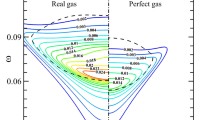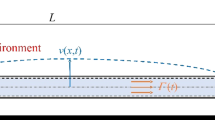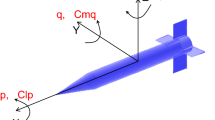Abstract
The impact of the energy input in the region in front of a model aircraft (a spherically blunted cylinder with wings and tail fins) on the structure of a viscous heat-conducting supersonic (M = 2.5) three-dimensional gas flow is numerically simulated. The simulations are performed using the unsteady Reynolds-averaged Navier–Stokes (URANS) equations and the Spalart–Allmaras (SA) turbulence model. The impact of the attack angle, parameters and placement of the energy input on the model’s aerodynamic characteristics (wave drag and lift) and heat flux on its surface is determined.

















Similar content being viewed by others
RЕFERENCES
P. Yu. Georgievskii and V. A. Levin, “Supersonic flows past bodies in the presence of external energy input,” Pis’ma Zh. Tech. Fiz. 14 (8), 684–687 (1988).
P. K. Tretyakov, A. F. Garanin, G. N. Grachev, V. L. Krainev, A. G. Ponomarenko, V. N. Tishchenko, and V. I. Yakovlev, “Control of supersonic flow around bodies by means of high-power recurrent optical breakdown,” Phys.-Dokl. 41 (11), 566–567 (1996).
G. G. Chernyi, Gas Dynamics (Nauka, Moscow, 1988; CRC Press, Boca Raton, 1994).
P. K. Chang, Separation of Flow (Pergamon, New York, 1970).
A. Sasoh, Y. Sekiya, T. Sakai, J.-H. Kim, and A. Matsuda, “Supersonic drag reduction with repetitive laser pulses through a blunt body,” AIAA J. 48 (12), 2811–2817 (2010). https://doi.org/10.2514/1.J050174
E. Erdem, K. Kontis, and L. Yang, “Steady energy deposition at Mach 5 for drag reduction,” Shock Waves 23, 285–298 (2013). https://doi.org/10.1007/s00193-012-0405-8
E. Schülein and A. Zheltovodov, “Effects of steady flow heating by arc discharge upstream of non-slender bodies,” Shock Waves 21, 383–396 (2011). https://doi.org/10.1007/s00193-011-0307-1
Yu. F. Kolesnichenko, V. G. Brovkin, O. A. Azarova, V. G. Grudnitsky, V. A. Laskov, and I. Ch. Mashek, “MW energy deposition for aerodynamic application,” in 41st Aerospace Science Meeting and Exhibit, Reno, NV, USA, 6–9 Jan. 2003, p. 2003-361. https://doi.org/10.2514/6.2003-361
S. M. Aulchenko, V. P. Zamuraev, and A. P. Kalinina, “Effect of one-sided unsteady energy supply on aerodynamic characteristics of airfoils in a transonic flow,” J. Appl. Mech. Tech. Phys. 49 (6), 957–961 (2008). https://doi.org/10.1007/s10808-008-0118-z
V. A. Levin and L. V. Terent’eva, “Supersonic flow around a thin airfoil in the presence of energy output in the neighborhood of its surface,” Report No. 4315 (Inst. Mekh. Mosk. Gos. Univ., Moscow, 1994).
S. Leonov, V. Bityurin, A. Yuriev, S. Pirogov, and B. Zhukov, “Problems in energetic method of drag reduction and flow/flight control,” in 41st Aerospace Science Meeting and Exhibit, Reno, NV, 2003, p. 2003-35. https://doi.org/10.2514/6.2003-35
P. Yu. Georgievskii and V. A. Levin, “Control of the flow past bodies using localized energy addition to the supersonic oncoming flow,” Fluid Dyn. 38 (5), 794–805 (2003). https://doi.org/10.1023/B:FLUI.0000007841.91654.10
O. Azarova, D. Knight, and Y. Kolesnichenko, “Pulsating stochastic flows accompanying microwave filament/supersonic shock layer interaction,” Shock Waves 21, 439–450 (2011). https://doi.org/10.1007/s00193-011-0319-x
P. Yu. Georgievsky and V. A. Levin, “Transformations of front separation regions controlled by upstream energy deposition,” in 45th AIAA Aerospace Sciences Meeting and Exhibit, Reno, NV, 2007, p. 2007-1232. https://doi.org/10.2514/6.2007-1232
V. A. Levin, N. E. Afonina, and V. G. Gromov, “Heat exchange control on sphere surface using a local energy input,” Fiz.-Khim. Kinet. Gazov. Din. (Phys.-Chem. Kinet. Gas Dyn.) 10 (2010).
P.-Q. Elias, “Numerical simulations on the effect and efficiency of long linear energy deposition ahead of a supersonic blunt body: Toward a laser spike,” Aerospace Lab, Issue 10, Paper AL10-03 (2015). https://doi.org/10.12762/2015.AL10-03
V. A. Levin, V. G. Gromov, and N. E. Afonina, “Numerical analysis of the effect of local energy supply on the aerodynamic drag and heat transfer of a spherically blunted body in a supersonic air flow,” J. Appl. Mech. Tech. Phys. 41 (5), 915–922 (2000). https://doi.org/10.1007/BF02468738
R. Kandala and G. V. Candler, “Numerical studies of laser-induced energy deposition for supersonic flow control,” AIAA J. 42 (11), 2266–2275 (2004). https://doi.org/10.2514/1.6817
K. Satheesh and G. Jagadeesh, “Experimental investigations on the effect of energy deposition in hypersonic blunt body flow field,” Shock Waves 18, 53–70 (2008). https://doi.org/10.1007/s00193-008-0140-3
L. V. Bykov, A. M. Molchanov, M. A. Shcherbakov, and D. S. Yanyshev, Computational Continuum Mechanics in Problems of Aviation and Space Technology (LENAND, Moscow, 2015) [in Russsian].
S. R. Allmaras, F. T. Johnson, and P. R. Spalart, “Modifications and clarifications for the implementation of the Spalart–Allmaras turbulence model,” in Seventh International Conference on Computational Fluid Dynamics (ICCFD7), Big Island, Hawaii, 2012, p. ICCFD7-1902.
J. R. Edwards and S. Chandra, “Comparison of eddy viscosity-transport turbulence models for three-dimensional, shock-separated flowfields,” AIAA J. 34 (4), 756–763 (1996). https://doi.org/10.2514/3.13137
S. V. Guvernyuk and K. G. Savinov, “Isobaric separation structures in supersonic flows with a localized inhomogeneity,” Dokl. Phys. 52 (3), 151–155 (2007). https://doi.org/10.1134/S1028335807030068
A. L. Afendikov, Ya. V. Khankhasaeva, A. E. Lutsky et al., “Numerical simulation of the recirculation flow during the supersonic separation of moving bodies,” Math. Models Comput. Simul. 12 (3), 282–292 (2020). https://doi.org/10.1134/S2070048220030035
Funding
The study was supported by the Russian Science Foundation, project 22-11-00126.
Author information
Authors and Affiliations
Corresponding author
Ethics declarations
The author declares that she has no conflicts of interest.
Rights and permissions
About this article
Cite this article
Khankhasaeva, Y.V. Impact of Energy Input on the Aerodynamic Characteristics and Heat Flux Occurring in the 3D Supersonic Flow Past a Model Aircraft. Math Models Comput Simul 15, 765–779 (2023). https://doi.org/10.1134/S2070048223040063
Received:
Revised:
Accepted:
Published:
Issue Date:
DOI: https://doi.org/10.1134/S2070048223040063




